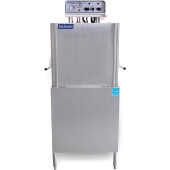goldstar
Senior Member
- Location
- New Jersey
- Occupation
- Electrical Contractor
Has anyone had experience with this commercial dishwasher ? It's a Jackson Tempstar unit (see nameplate attached. I have a campground facility that doesn't have too many power options available. They have a 200A, 208 1 phase service to the food pavilion and also a 200A, 240V 3 phase w/ high leg. Both panels are about 150-200' away from the area they want to install this unit. I would have to do some fancy re-structuring of the 3 phase panel in order to get a 3-pole breaker in it. The panel is in a common toilet area and not too much room to work.
Anyway, the reason I'm asking is should I assume that wash motor, wash heater and rinse motor could possible all run at the same time ? 51 amps and a 200' run in PVC is pushing the envelope for this.
Appreciate your thoughts.
Anyway, the reason I'm asking is should I assume that wash motor, wash heater and rinse motor could possible all run at the same time ? 51 amps and a 200' run in PVC is pushing the envelope for this.
Appreciate your thoughts.


